Spring truly arrived this week in our part of KwaZulu-Natal with a full day of gentle rains, softening the hard soil after a long dry winter. Fresh leaves are unfurling on deciduous trees and flowers are in bud or already blossoming.
However, the most famous spring flowers in South Africa are in the winter rainfall areas of the Western Cape. This year the region had a bumper flower season and although – because of the Covid-19 pandemic – international tourists were not able to be here to see it, lockdown restrictions were eased just in time to enable local people to self-drive to enjoy the spectacle of colourful spring flowers carpeting the landscape.
After seemingly peaking during July, Covid-19 infections and associated hospitalisations continue to drop steadily across the country, even though lockdown regulations were relaxed to ‘level 2’ in mid-August. This week our president announced a further relaxation of lockdown regulations – moving to ‘level 1’ from 21 September – with the easing including moderating further existing restrictions on travel. International travel to and from South Africa, although under constraints, will recommence from 1 October.
So it seems appropriate enough to share spring flower photographs taken on a day trip we did while on holiday in Cape Town (a few years back) to the West Coast National Park, as a celebration of spring and as an acknowledgement that tourism may cautiously start emerging within the context of the ‘new normal’ with various health protocols in place.
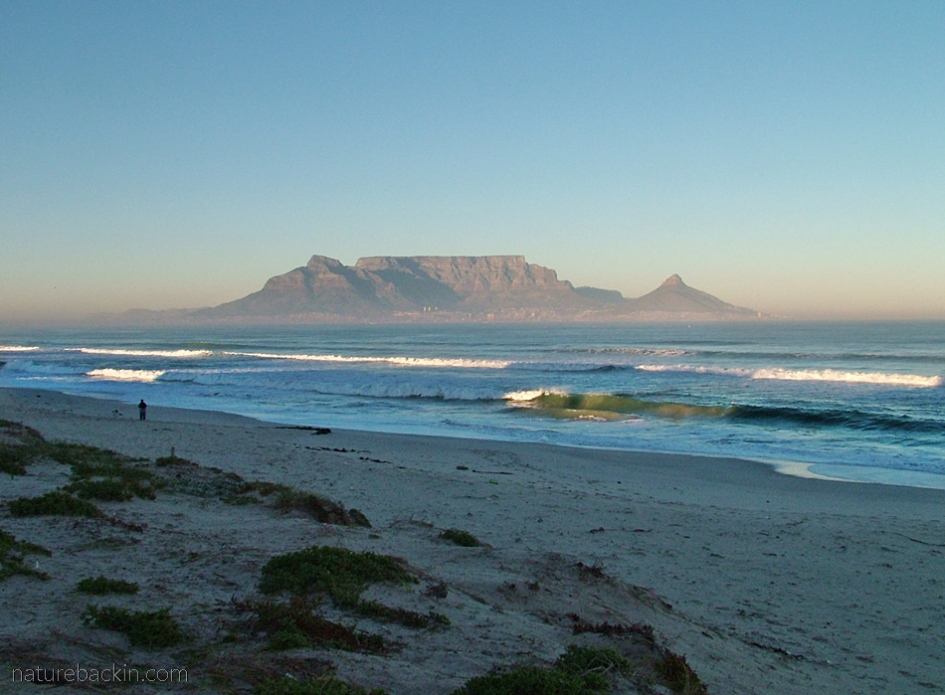
On our daytrip from Cape Town to the West Coast National Park, we stopped off at Bloubergstrand, with its famous view across Table Bay to Cape Town, to photograph Table Mountain catching the first light of the rising sun
Our holiday to Cape Town took place in August (2007) and coincided with flower season in the Postberg section of the West Coast National Park, renowned for the spring flowers that brighten the strandveld (coastal vegetation) with a vast array of colourful blooms.
The West Coast National Park is about 120 km (75 miles) north of Cape Town and lies along the Atlantic coastline from just north of Yzerfontein in the south extending up to and surrounding the saltwater Langebaan Lagoon in the north and including an adjacent inland area. The Postberg region of the park lies on the strip of land between the Atlantic Ocean and the Langebaan lagoon. (For maps see here).
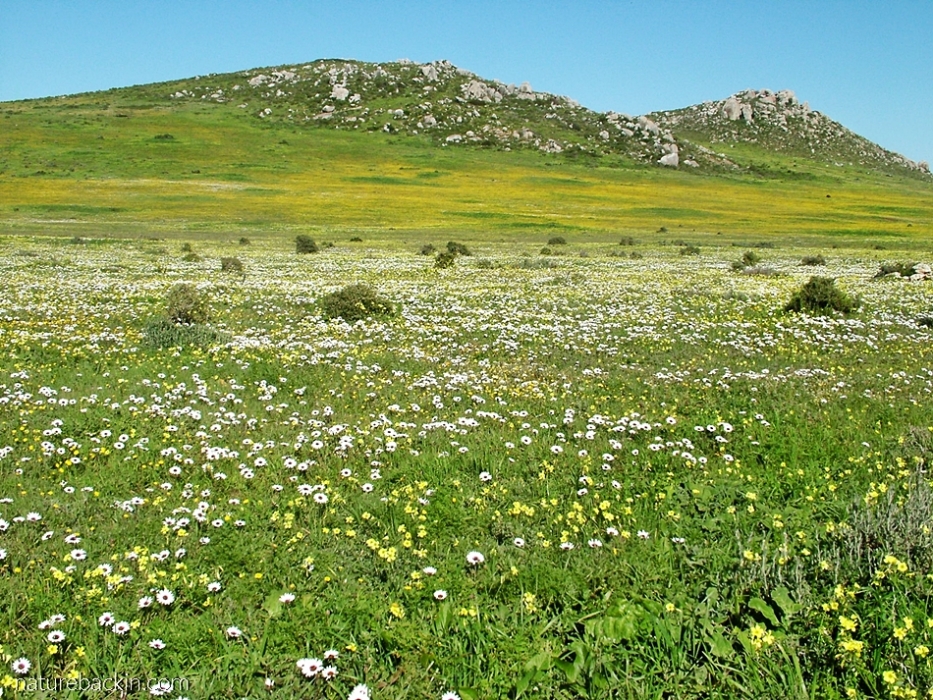
The two main vegetation types in the Postberg Nature Reserve – Saldanha Limestone Strandveld and Saldanha Granite Strandveld – are endemic to the Saldanha Bay region, which includes the West Coast National Park. Both vegetation types feature many threatened species and because a high percentage of the relatively small original extent of these vegetation types has already been lost to agriculture and development, what remains is critical for biodiversity.
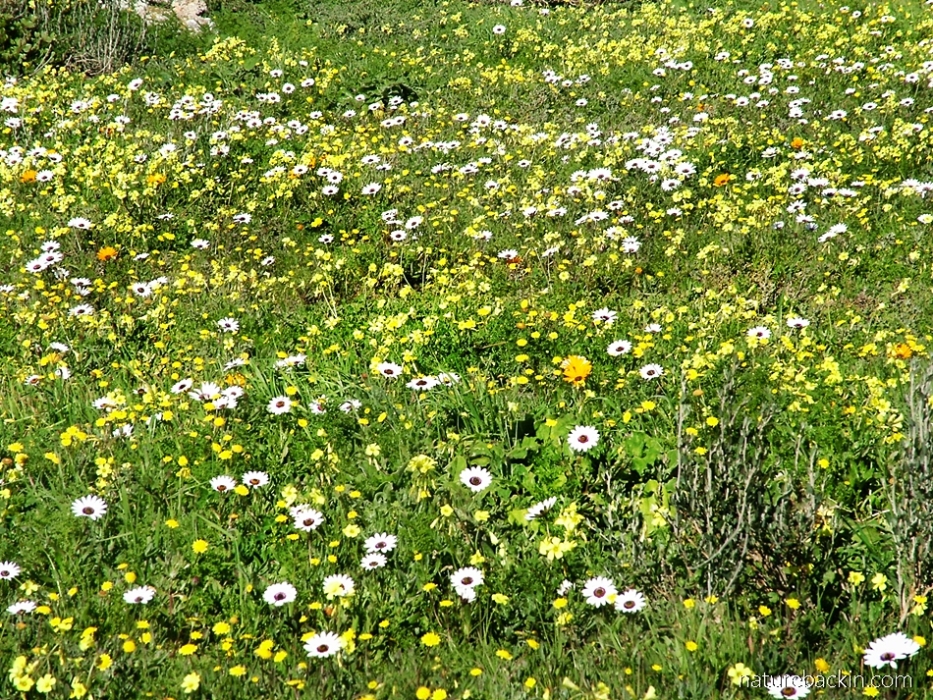
Spring flowers in August in the Postberg section of the West Coast National Park. Postberg is open to the public only during the flower season, in August and September each year
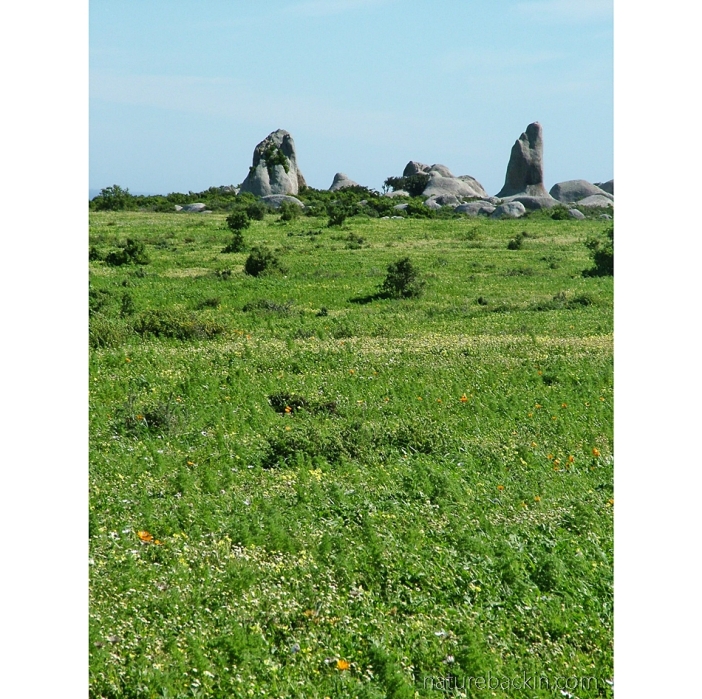
A view to the distance granite rock spires known as the Vingerklippe (finger rocks) that can be approached by following one of Postberg’s walking trails
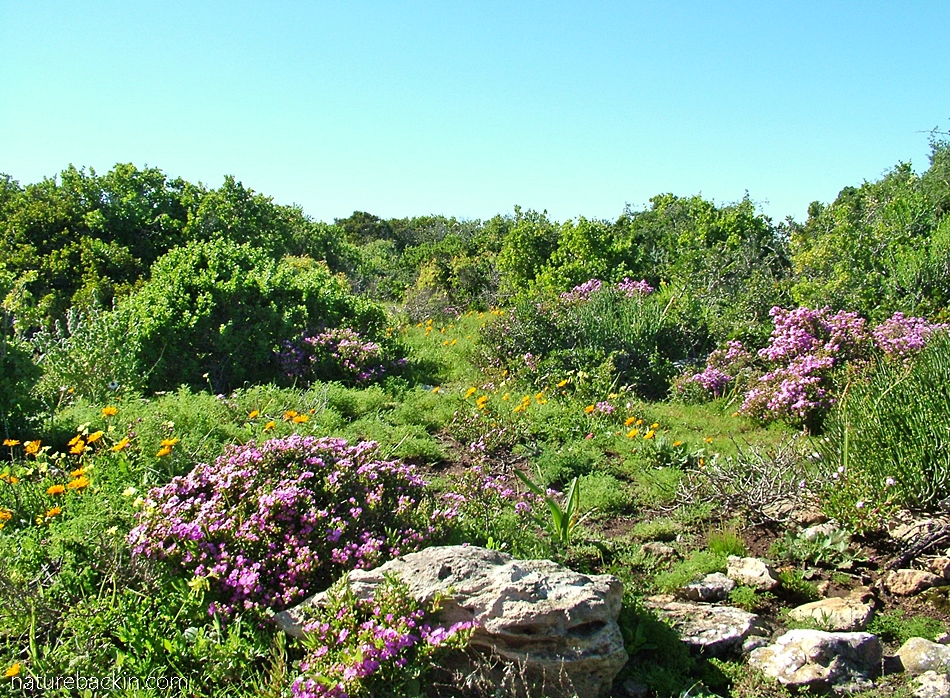
Nature’s garden – the splashes of mauve are from one of the many succulent vygies, possibly Lampranthus amoenus. The orange daisies are likely to be the Namaqualand marigold, Arctotis hirsuta
I have written in a previous post about the exceptional diversity and richness of the Cape Floral Kingdom in the extreme southern and western regions of South Africa. Although it is limited to only 6% of the country it contains 8 700 species, many of them extremely localised endemics.
Strandveld vegetation is considered to be a subtype of the fynbos biome. It is coastal vegetation that is limited to the Cape Floral Kingdom region and includes shrubby and succulent perennials. Annuals occur in disturbed ground. Postberg was formerly farmland, and perhaps the disturbance resulting from former livestock farming partly accounts for the high number of annuals that flower in the spring.
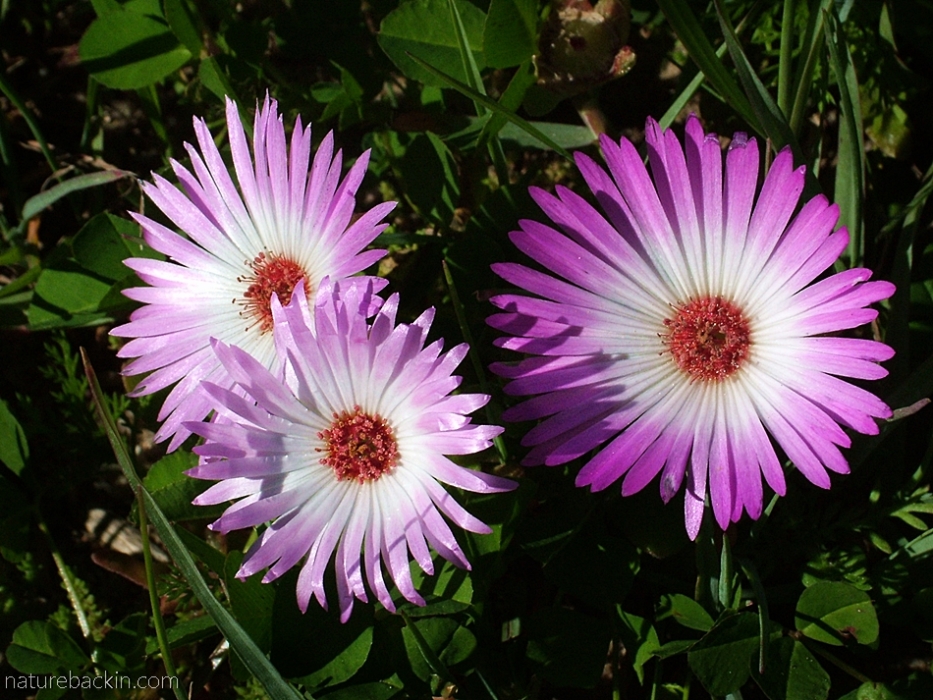
This is another member of the vygie (Aizoaceae) family of succulent plants: Livingstone daisies (Cleretum bellidiforme) also known as Bokbaai vygies. This plant with pale-centred flowers is one of the many colour variants of the Bokbaai vygie
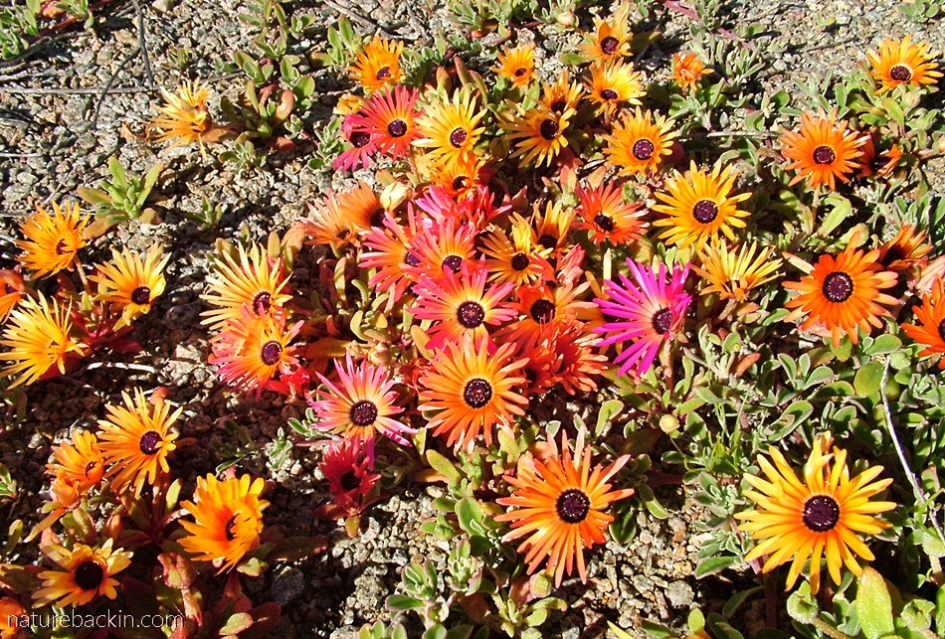
I think this is one of the many other colour variants of the Bokbaai vygies
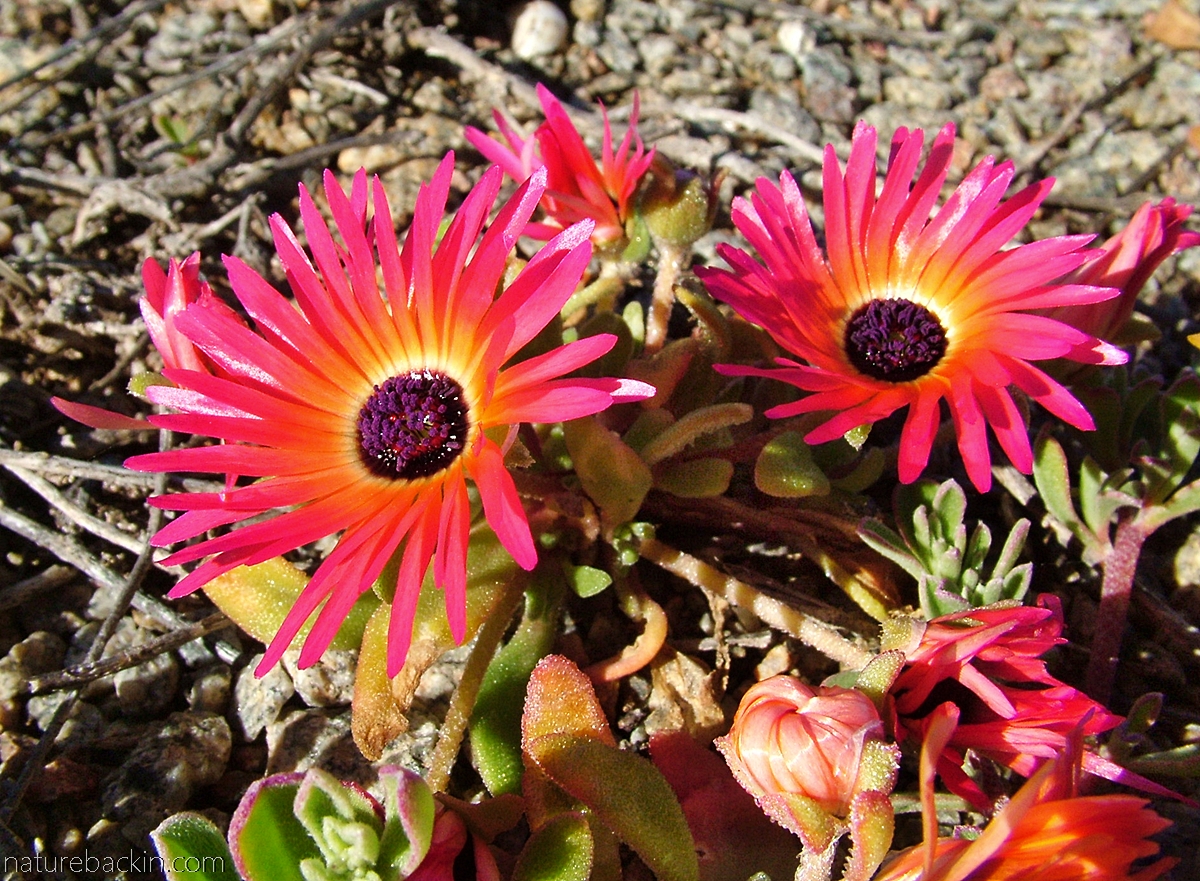
A close-up of these day-glo flowers
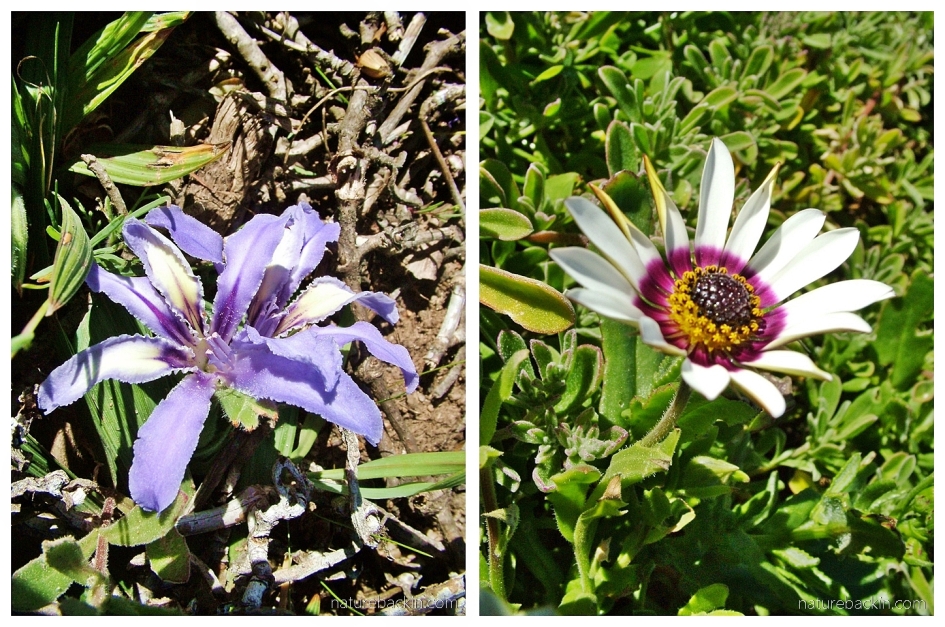
One of the low-growing babiana species (possibly Babiana ambigua) on the left above, and the white rain daisy (Dimorphotheca pluvialis), which flowers in great profusion at Postberg

Oxalis in several colours occur in the region. This salmon-coloured flower is Oxalis obtuse, also known as yellow-eyed sorrel

The lovely blue of the wild or blue flax (Heliophila coronopifolia), also known as sporrie, adds another dimension to the mix of blooms. It is one of the 71 species of Heliophilia growing in the Namaqualand and south-western Cape regions

A view across the flowers to the Atlantic Ocean forming the distant horizon
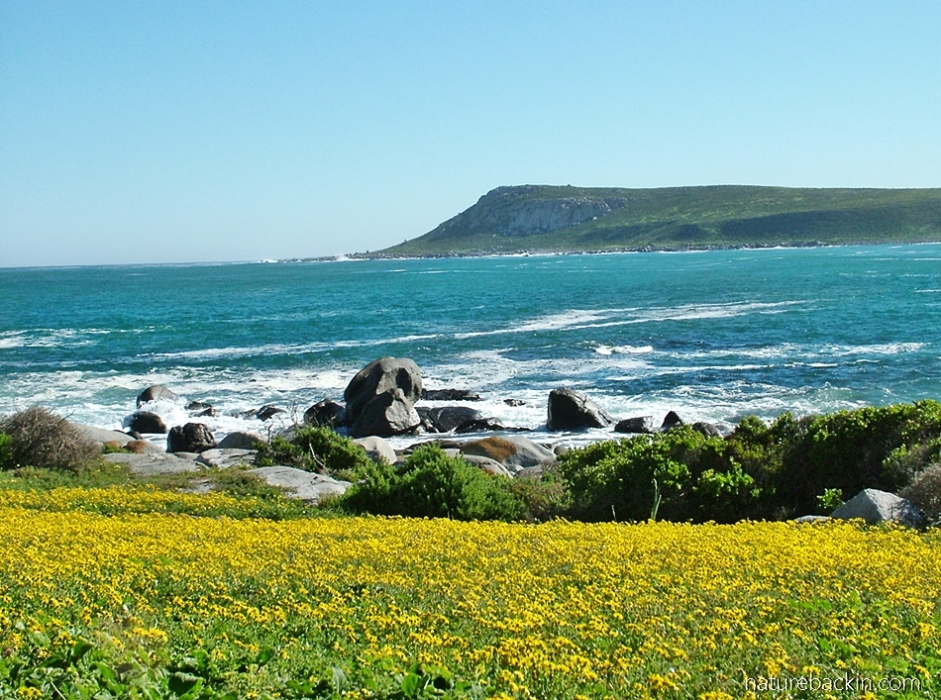
The waves from the Atlantic roll into Plankiesbaai in the north-west corner of the Platberg nature reserve

Granite boulders are characteristic of this part of the west coast
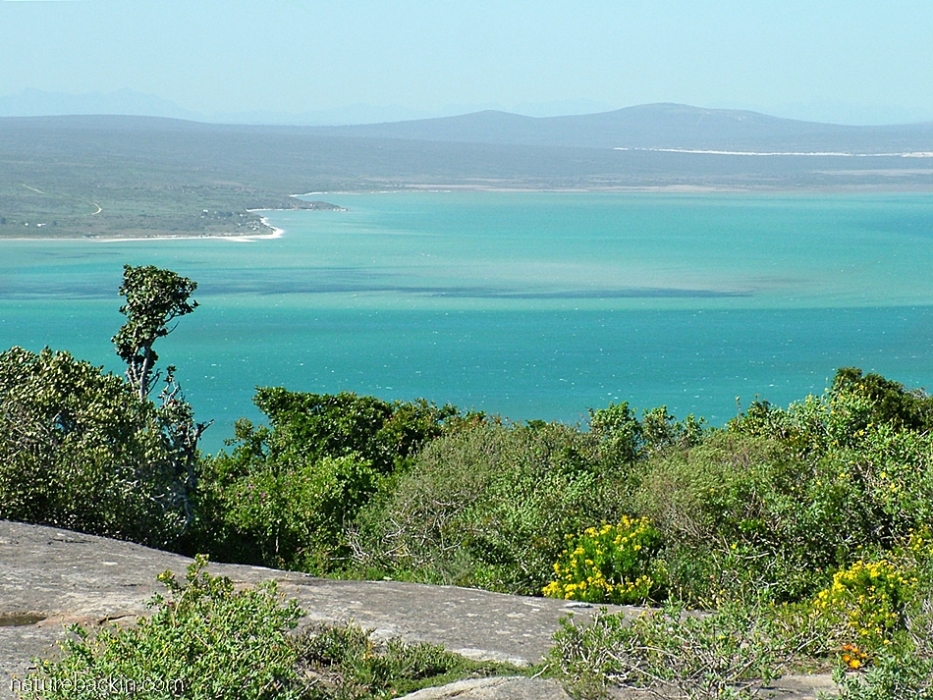
From a viewpoint in Platberg, the turquoise waters of Langebaan lagoon can be seen below
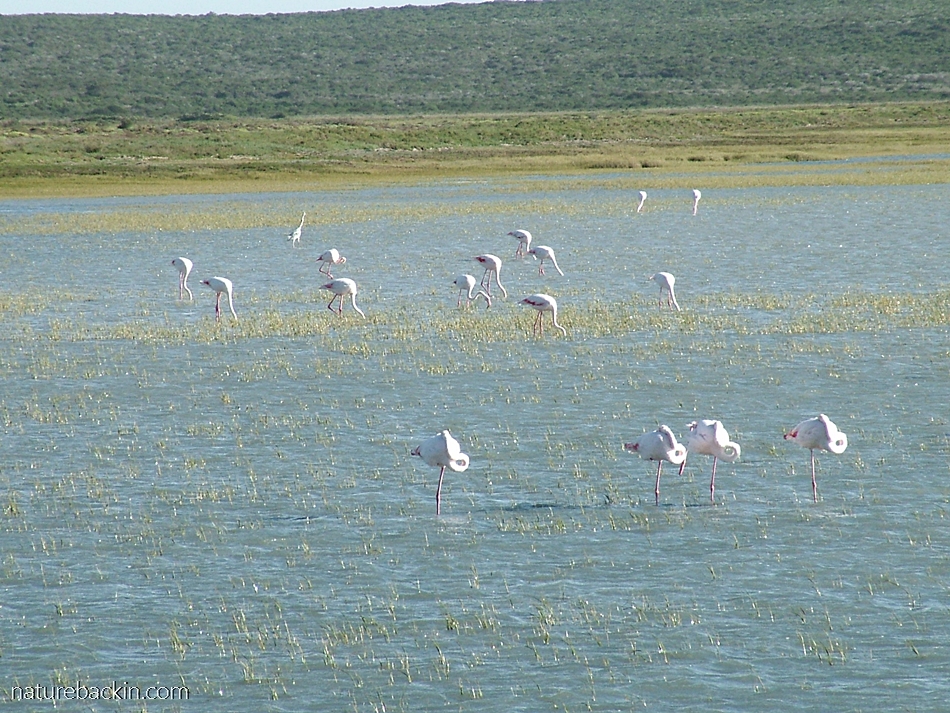
Flamingos resting or searching for food while wading in the shallow waters of Langebaan Lagoon.
Langebaan Lagoon is of great ecological significance, not least for water birds, and it is on the Ramsar list of Wetlands of International importance. Despite this status, the lagoon is under considerable pressure from human activities and industries in the Saldanha Bay region
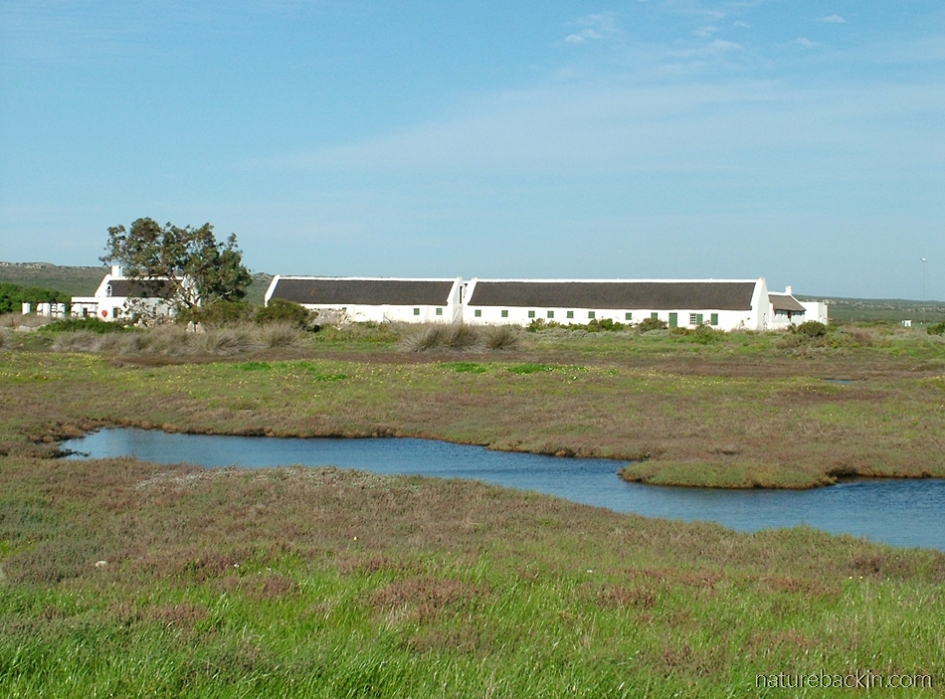
Part of the marshland at the southern end of Langebaan Lagoon with the Geelbek visitor centre and restaurant in the background. The Cape Dutch-style buildings date back to 1744
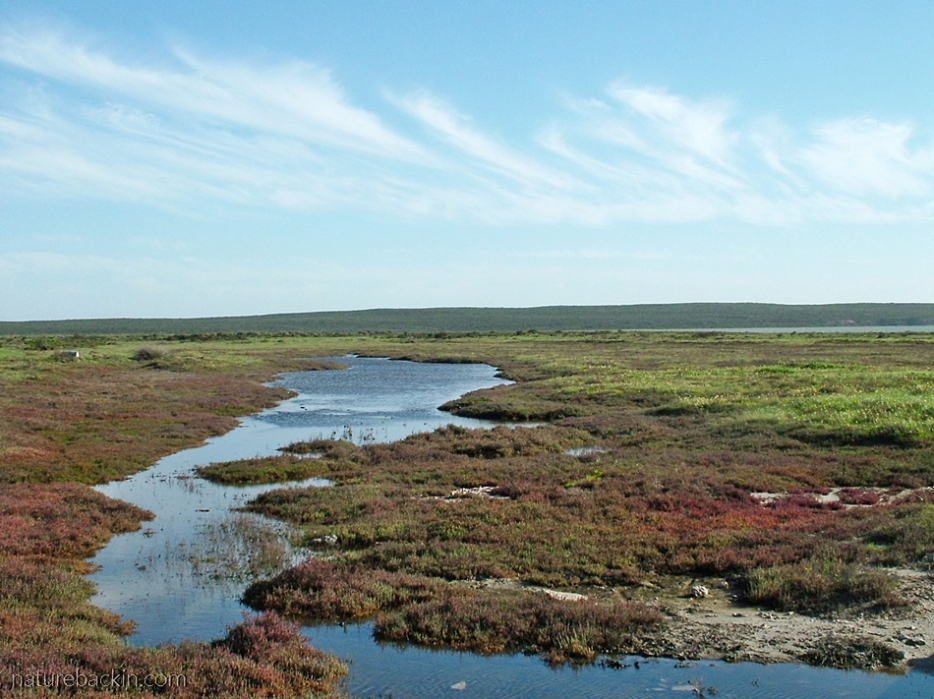
Marshland at the southern end of Langebaan Lagoon
Athough almost microscopic in comparison, of course we do have springtime to celebrate in our garden, which I have posted about before, see for example One fine spring day thirty minute photo shoot and Spring is bursting, but it has been nice to expand horizons and revisit springtime on the west coast.
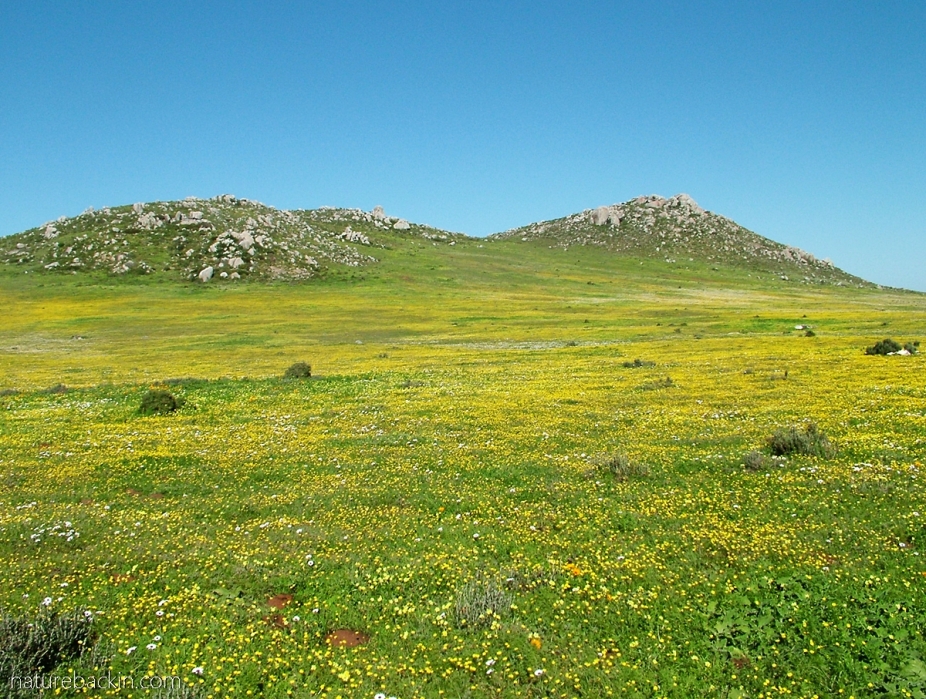
Black sparrowhawk update: Since last week’s post I have seen the female black sparrowhawk once in her favourite perching tree, once in the nesting tree and I have also heard her calling from the plantation. But we have also seen an African harrier-hawk fly into the nesting tree on two separate occasions, but we have not seen any activity at the nest – not that we have made the time to watch the nest for extensive periods. So at least one of the black sparrowhawks is still around, but whether the youngster is still in the nest I don’t know. Also during this week, the Egyptian geese have disappeared from the neighbourhood despite being so noisily active and present in the preceding few weeks.

Sources: Chapman Poulsen, Zoë. 2020. Spring Flower Watch: West Coast National Park. https://botsocblog.wordpress.com/2020/09/02/spring-flower-watch-west-coast-national-park/; Sanparks. [n.d.] West Coast National Park: Park History. https://www.sanparks.org/parks/west_coast/about/park_history.php. ; Van der Walt, Liesl. 2000. Heliophila coronopifolia. South African National Biodiversity Institute (SANBI). http://pza.sanbi.org/heliophila-coronopifolia
Posted by Carol

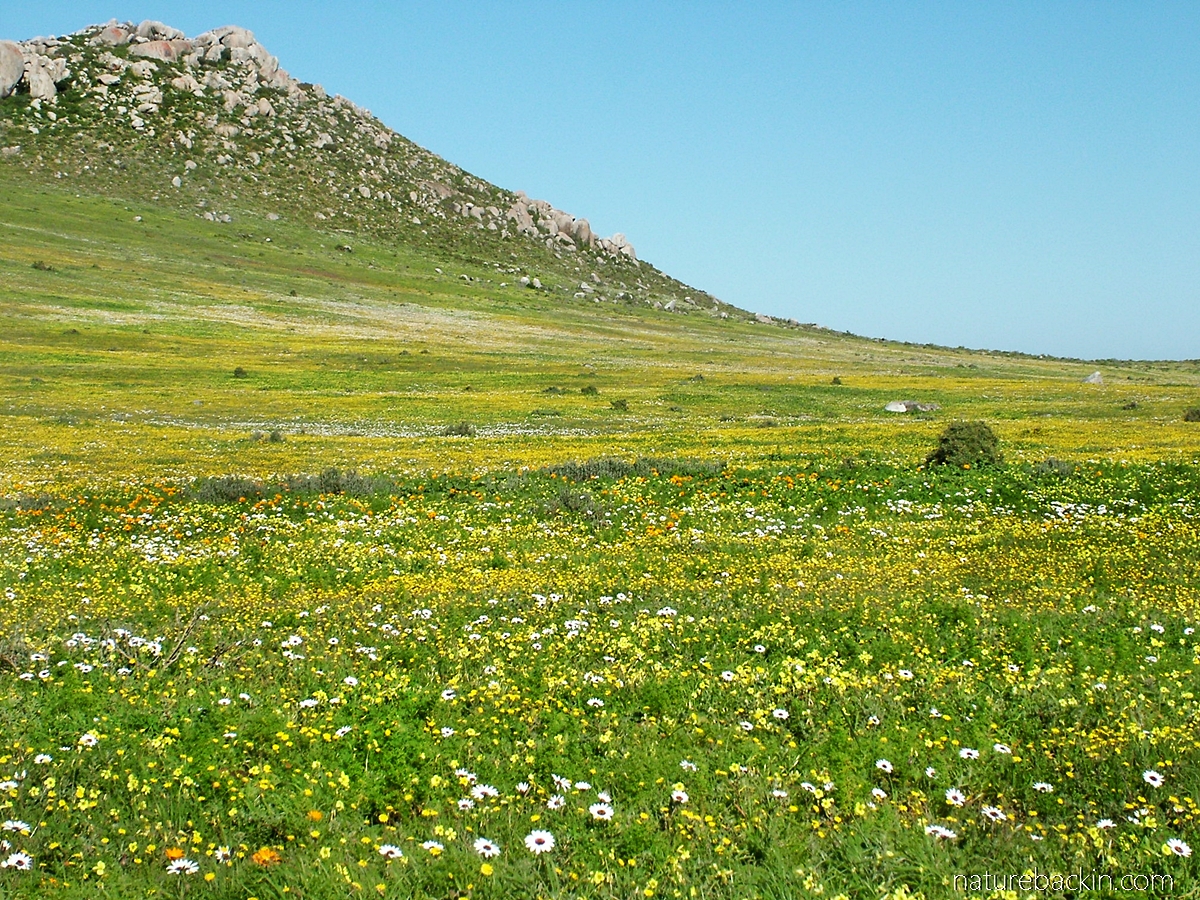







October 17, 2020 at 9:26 am
Stunning! Wild gardens are special.
LikeLiked by 2 people
October 17, 2020 at 2:05 pm
Nature’s gardens are matchless!
LikeLiked by 1 person
September 25, 2020 at 8:57 am
Glad I didn’t miss this post – a celebration of colour and biodiversity! And tentative good news on the Covid front and with the sparrowhawks. Here, of course, we head into autumn – and rising infection rates, tighter restrictions and an extended period of uncertainty, all of which makes the encouraging news from SA all the more welcome.
LikeLiked by 2 people
September 25, 2020 at 6:40 pm
Thanks Sandra, and it was nice to celebrate spring with those West Coast flowers. Our Covid infection rates continue to decline mercifully, although of course there are worries that they will start rising again as people gather during the summer holidays, as that has been the case elsewhere.
Rising infections in the UK and many other countries is extremely concerning. I hope you are able to stay safe during all this ongoing uncertainty.
LikeLiked by 1 person
September 23, 2020 at 1:47 am
What a delight, Carol. Some distinct similarities to the northern California coast, but without the Flamingos. At first glance I thought they were our Egrets, but a closer look changed my mind.
Watching over the survival of baby birds is fraught with anxiety. Though I tell myself it’s life in the wild.
LikeLiked by 2 people
September 23, 2020 at 1:50 am
Oops, looks like Jane got here first with the observation of similarities to California wildflowers. Except for the seasons. 😉
LikeLiked by 1 person
September 23, 2020 at 8:06 pm
Well its interesting that you both make that comparison – although, as you note we are having spring as you are experiencing autumn. I wonder how bad the smoke from the fires is in your region now?
LikeLike
September 24, 2020 at 2:53 am
No surprise that Jane and I would make the same comparison since I’ve traveled many of those same areas she’s posted when the hills were awash in similar flowers. It’s such a bright cheery vision. As for smoke. We were the lucky ones this time since the winds shifted (FINALLY… after stalling over us for about a week) and sent the smoke headed back East where it came from. Not so lucky for those in the interior valleys, but we had about a week of sun and fluffy clouds.
Today, as we headed north for some supplies (mostly food), we were hit with what our charming and clever weather people are now calling an “atmospheric river”… Apparently the older term “Pineapple express” isn’t politically correct these days. We’re just grateful for glorious rain on a parched landscape. I’m hoping this also clears the smoke out of the interior valleys that had the worst of the fires and smoke. Hopefully the rain won’t create some nasty mud slides where the hillsides were denuded by the fires.
LikeLiked by 1 person
September 24, 2020 at 10:07 pm
Glad to hear that you had a break from the smoke and now much needed rain. Can only hope it does a lot of good and does not provoke any mud slides as you say. Everybody needs some kind of respite from the fires, not least the fire fighters.
LikeLike
September 23, 2020 at 8:04 pm
Thanks Gunta. I have seen photos of the wild flower season in parts of California and it is spectacular.
There is no activity at the sparrowhawks’ nest but they are still around, and it is possible they have started another nest but further away, though its hard to tell.
LikeLike
September 21, 2020 at 5:15 pm
Marvelous photos and info, Carol. Some of your images remind me of wildflower season in California along the coast. I imagine there is overlap of flower types? How wonderful that you are having such an explosion of beauty in your world. And I loved your flamingos. Enjoy every minute! 🙂
LikeLiked by 2 people
September 23, 2020 at 8:01 pm
Thanks very much Jane. I have no idea what plants the regions have in common, unfortunately.
We are enjoying spring, although we live on the eastern side of the country and so spring here is rather different than in the Cape as we theoretically go into our wet season. Sadly, not much rain is forecast to follow up on the promising day of rain we had last week …
I am sorry to read that wild fires in parts of California and Oregon are continuing on.
LikeLiked by 1 person
September 23, 2020 at 11:03 pm
Thanks, Carol. Hopefully better days ahead. I can see the smoke over the mountain from one wildfire from my window. We are ok, but it’s quite disconcerting.
LikeLike
September 19, 2020 at 5:49 am
Wildflower meadows are so lovely, such an array of colors. That looks like a great park to visit. No wonder it’s popular. Good luck with reopening the doors to visitors. Our date keeps getting pushed back with surges here and especially on Oahu. And, frankly, the mainland isn’t exactly doing great either. I don’t expect much to happen until next year, after the election.
LikeLiked by 2 people
September 20, 2020 at 7:52 pm
Indeed opening up to visitors is complicated. The finer details for visitors still have not been announced, but visitors will be expected to have had Covid-19 tests within 72 hours prior to arriving in SA. Not sure how that works as it can be difficult to get results to tests assuming one has access to tests in the first pace. If no negative test result or if showing symptoms on arrival then visitors will need to go into two weeks quarantine at their own expense.
I can understand why dates where you are keep getting moved.
Infections rates here have risen slightly over the last three days but we need more time to see if this is the beginning of a new surge or not …
LikeLiked by 1 person
September 21, 2020 at 4:00 am
Over the past two months the dates keep getting put back as the situation changes. There are plans for people being able to avoid quarantine through pre-flight testing, but really no one knows whether that will work or not. I hope it works out for you in SA.
LikeLiked by 1 person
September 23, 2020 at 7:53 pm
Thanks – the details are not finalised yet. Only time will tell, I guess.
LikeLiked by 1 person
September 18, 2020 at 8:43 am
These spectacular photographs must have made you long to return to the West Coast. Maybe next spring? I was glad to hear that you have had good rains and are enjoying spring in your backyard, as it were. Thank you for the news of the sparrowhawk
LikeLiked by 2 people
September 18, 2020 at 6:02 pm
Maybe next spring …
The rain was welcome and gentle – but just one day. Hoping for more of course. I hope this season brings much needed rain to your region too. I gather you have not had anything yet.
LikeLike
September 18, 2020 at 6:05 pm
Dry as a bone here. Wishing for rain everywhere
LikeLiked by 1 person
September 20, 2020 at 7:37 pm
Oh dear – yes let’s hope this season brings rain …
LikeLiked by 1 person
September 18, 2020 at 6:41 am
Wonderfully rugged scenery and colourful flowers. What a treat to visit such a well preserved area. I think it would be better without the international travellers!
LikeLiked by 2 people
September 18, 2020 at 5:56 pm
Yes it is great that this area is now protected. Amazingly the flowers are such an attraction that even without international travellers local visitors formed incredibly long traffic queues to get into the park this season. Rebounding from the more severe part of the lockdown perhaps.
LikeLiked by 1 person
September 18, 2020 at 6:33 am
Wow wow wow. How beautiful. Definitely on my bucket list.
Thanks Aunty Carol. 🌸❤️
LikeLiked by 2 people
September 18, 2020 at 5:52 pm
Thanks Debs – the flowers are amazing to see. I can see why Namaqualand draws so many visitors in the flower season. Hope you get to a west coast springtime before too long xxx
LikeLiked by 1 person
September 18, 2020 at 5:40 am
I would love to experience this flowering extravaganza first hand! I understand that – even sans overseas tourists – the queues to enter the park were very long indeed. This is a testament to the number of people who are prepared to travel to the area to enjoy seeing nature’s bounty. I am thus particularly happy to see the splendour through your lens. I hope we too will get to enjoy some gentle rain before long. Thank you for the update on the birds!
LikeLiked by 2 people
September 18, 2020 at 5:48 pm
Hi Anne – it was lovely to see the flowers and that we were able to do it when in Cape Town was entirely serendipitous. There was a petrol shortage at the time that made it a bit touch and go too.
I read about the traffic queues to get into the park this year – gives a different meaning to a bumper season!
Oh no I thought your region might have had some rain too this past week. Fingers crossed you get some soon. We don’t have much forecast for the next 10 days or so …
I will continue to keep half an eye out on the birds.
LikeLiked by 1 person
September 18, 2020 at 1:40 am
A symphony of colour to accompany a ballet of delight at the arrival of spring and freedom to explore our wild places again!
LikeLiked by 2 people
September 18, 2020 at 5:43 pm
I love your poetic response – inspired by spring and the prospect of exploring in the wild again! It is amazing how energizing spring can be. Let’s hope for more gentle rains …
LikeLiked by 1 person
September 17, 2020 at 9:53 pm
Such a beautiful place – I love seeing vast expanses of wildflowers stretching away to the horizon. The sea makes an exceptional backdrop!
LikeLiked by 2 people
September 18, 2020 at 5:36 pm
Yes it is beautiful and the sea adds another dimension to what is already spectacular. I recall a post you did featuring those wonderful orange poppies in a superbloom season in California if I remember correctly? Truly stunning.
LikeLike
September 19, 2020 at 1:18 am
Yes, the SA fields remind me of those western US meadows… truly amazing to see.
LikeLike
September 17, 2020 at 8:52 pm
What incredibly beautiful flowers in a range of colors and shapes!
LikeLiked by 2 people
September 18, 2020 at 5:33 pm
Hi Sandy – yes the range in diversity is incredible, and so beautiful too!
LikeLiked by 1 person
September 17, 2020 at 8:22 pm
Thanks for the update! And thanks for this flower bonanza. What astonishing profusion and diversity!
LikeLiked by 2 people
September 17, 2020 at 8:27 pm
It certainly is astonishing and a wonderful spectacle.
LikeLiked by 1 person